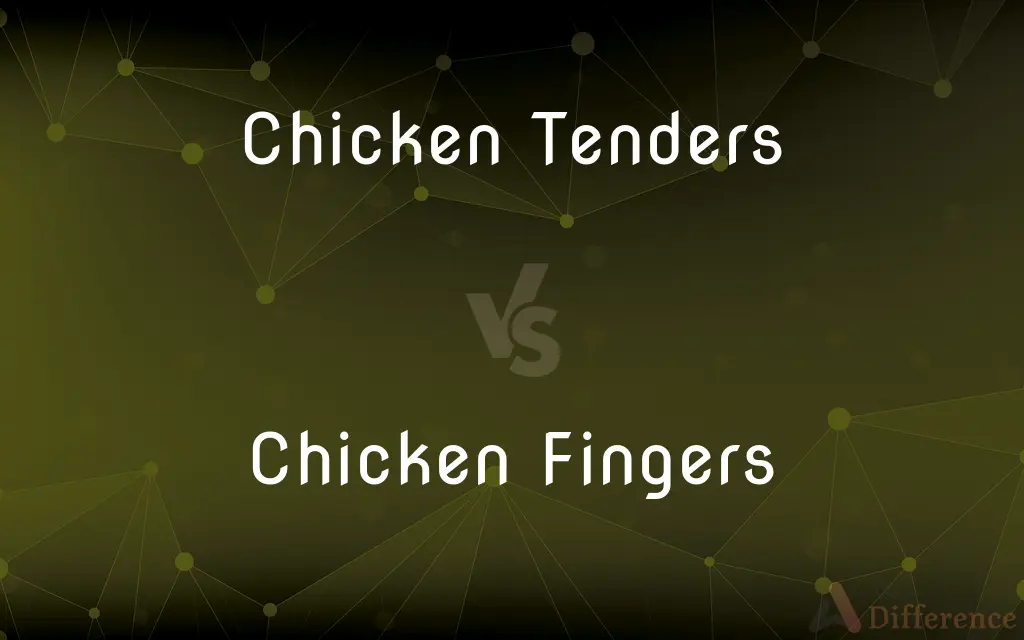Chicken Tenders vs. Chicken Fingers — What's the Difference?
By Tayyaba Rehman & Fiza Rafique — Published on October 26, 2023
Chicken Tenders are strips from the tenderloin, a meaty part of the chicken breast. Chicken Fingers are breaded and fried chicken strips, not necessarily from the tenderloin.

Difference Between Chicken Tenders and Chicken Fingers
Table of Contents
ADVERTISEMENT
Key Differences
Chicken Tenders refer specifically to a part of the chicken breast called the tenderloin. This is a distinct piece of meat that is considered tender, hence the name. It's located underneath the main portion of the breast, and is separate from the rest of the meat. When it's prepared without breading or frying, it retains the name Chicken Tenders.
On the other hand, Chicken Fingers are chicken strips that are breaded and then fried or baked. While they can be made from the tenderloin, they don't have to be. Essentially, any piece of chicken meat that is cut into strips, breaded, and cooked can be called Chicken Fingers.
The name "Chicken Tenders" is rooted in the particular cut of meat being used. Many restaurants and chefs value this part for its softness and ease of preparation. Chicken Tenders can be grilled, fried, breaded, or even baked, offering a versatile choice for many dishes.
In contrast, Chicken Fingers are often associated with a specific preparation method. The emphasis is on the breading and the method of cooking. Often seen as a favorite among children, Chicken Fingers are a popular choice in many restaurants, especially in the fast-food sector, and are recognized for their crispy exterior.
While both Chicken Tenders and Chicken Fingers are popular choices for meals, the main distinction lies in the source of the meat and the preparation method. However, the terms are sometimes used interchangeably, depending on the region or restaurant, which can cause some confusion.
ADVERTISEMENT
Comparison Chart
Part of Chicken
Specifically from the tenderloin of the breast
Any part of chicken, cut into strips
Preparation
Can be breaded, fried, grilled, or baked
Typically breaded and fried or baked
Texture
Tender and soft
Crispy exterior due to breading
Usage
Often used in more upscale or varied dishes
Common in fast food and popular among children
Association
Named for the specific cut of meat
Named for the finger-like shape and preparation method
Compare with Definitions
Chicken Tenders
Strips from the tenderloin of the chicken breast.
She ordered grilled Chicken Tenders for a healthier option.
Chicken Fingers
Breaded and fried chicken strips.
The kids love ordering Chicken Fingers with honey mustard sauce.
Chicken Tenders
Soft and meaty parts located under the main breast.
Chicken Tenders are a favorite due to their tender texture.
Chicken Fingers
Often served with a variety of dipping sauces.
The Chicken Fingers came with barbecue and ranch dips.
Chicken Tenders
Can be prepared in various ways including frying or grilling.
The restaurant offers both fried and grilled Chicken Tenders.
Chicken Fingers
Recognized for their crispy exterior.
The golden brown Chicken Fingers were a hit at the party.
Chicken Tenders
Often served in dishes requiring a softer chicken texture.
The salad had pieces of Chicken Tenders as the protein source.
Chicken Fingers
A popular fast-food and casual dining item.
Most fast-food chains have their version of Chicken Fingers.
Chicken Tenders
Considered a premium cut in culinary contexts.
The chef used Chicken Tenders for the special dish of the day.
Chicken Fingers
Can be made from various parts of the chicken.
These Chicken Fingers are made from thigh meat for extra juiciness.
Common Curiosities
Are Chicken Fingers always breaded?
Typically, yes. Chicken Fingers are recognized for their breaded and fried preparation.
Which is generally softer, Chicken Tenders or Chicken Fingers?
Chicken Tenders are usually softer due to the tenderloin's texture.
Are Chicken Fingers named because they're finger food?
Partially. They're also named for their finger-like shape.
Are Chicken Tenders always from the tenderloin?
Yes, Chicken Tenders specifically refer to strips from the tenderloin of the chicken breast.
Can Chicken Tenders be breaded?
Yes, Chicken Tenders can be breaded, fried, grilled, or even baked.
Is there a taste difference between Chicken Tenders and Chicken Fingers?
The main difference lies in texture and preparation, but taste can vary based on seasoning and cooking method.
Do all restaurants differentiate between the two?
No, some use the terms interchangeably, but the preparation and source of meat might differ.
Are Chicken Tenders more expensive?
They can be, depending on the restaurant and the dish, due to the specific cut of meat.
Can Chicken Fingers be made from Chicken Tenders?
Yes, Chicken Tenders can be breaded and fried to become Chicken Fingers.
Which is healthier, Chicken Tenders or Chicken Fingers?
Unbreaded Chicken Tenders are typically healthier than breaded and fried Chicken Fingers.
Do Chicken Tenders contain bones?
No, they are boneless strips from the chicken's tenderloin.
Which is more popular in fast-food chains?
Chicken Fingers are more commonly found in fast-food chains due to their breaded and fried nature.
Are Chicken Fingers suitable for all age groups?
Yes, they are popular among children but are enjoyed by people of all ages.
Can Chicken Fingers be baked?
Yes, they can be baked for a healthier alternative to frying.
Are Chicken Fingers and Chicken Strips the same?
Essentially, yes. Chicken Strips is another name for Chicken Fingers.
Share Your Discovery

Previous Comparison
Unity of Command vs. Unity of Direction
Next Comparison
National Language vs. Official LanguageAuthor Spotlight
Written by
Tayyaba RehmanTayyaba Rehman is a distinguished writer, currently serving as a primary contributor to askdifference.com. As a researcher in semantics and etymology, Tayyaba's passion for the complexity of languages and their distinctions has found a perfect home on the platform. Tayyaba delves into the intricacies of language, distinguishing between commonly confused words and phrases, thereby providing clarity for readers worldwide.
Co-written by
Fiza RafiqueFiza Rafique is a skilled content writer at AskDifference.com, where she meticulously refines and enhances written pieces. Drawing from her vast editorial expertise, Fiza ensures clarity, accuracy, and precision in every article. Passionate about language, she continually seeks to elevate the quality of content for readers worldwide.












































